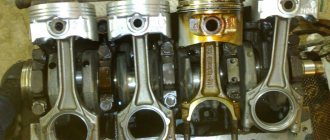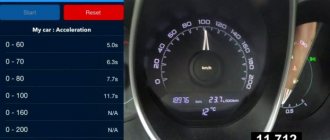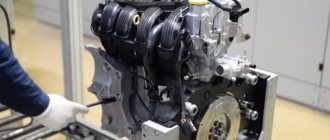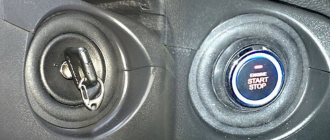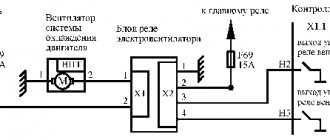What is the most important thing in a car? Wheels, interior, and maybe suspension - We believe that when choosing a car, everything is important. But the engine is the most important factor when deciding to buy a car. The Lada Vesta is powered by 3 modern engines from AvtoVAZ. Any car enthusiast would be curious to know in detail about each of them.
In total, the review material will consider three main types of engine:
— engine 21129 from VAZ — technical problems, characteristics; — 21179 from VAZ — the new top-end 1.8 engine is installed on the latest modifications, including the Lada Vesta SW Cross; The HR16DE-H4M propulsion system from Nissan is a chain motor with an impressive resource, but manual valve adjustment.
- What engine is installed on the Lada Vesta
- Motor VAZ 21129
- Motor VAZ 21179
- Engine Renault-Nissan H4M-HR16 DE
- Lada Vesta engine life - you need to know
- Subtle Features
What engine is installed on the Lada Vesta
The main engines for the Lada Vesta, which are installed by the manufacturer, are already indicated in the introduction. The company's decision to refuse to install the VAZ-11189 engine in the basic configuration was a winner. It seriously idles even on Grant and Priora; in fact, it is a modification of the VAZ-11186 model known to many. The only difference is that it has different intake and exhaust valves. The decision is due to the heavier body of the new car and increased requirements for the driving characteristics of the installed engine. There are three types of installations with different characteristics installed on cars. Two with a volume of 1.6 liters. and one 1.8 l. At 21179 AvtoVAZ had to increase engine power by 14 horses, without increasing appetite.
While writing this review, they traveled thousands of kilometers and we are ready to talk about the results. Recently, a wave of discussions was caused by the fact that one of the engines was not developed by VAZ, but will be supplied by Japanese manufacturers. Moreover, instead of the usual timing belt, it has a chain and it has more power. This allows you to seriously increase the power output of the motor. Is a chain better than a good engine belt?
Perspective
It should be noted that the power unit from the Nissan concern is superior to our domestic engines both in many quality and technical characteristics and in terms of efficiency (more reliable, more durable and uses less oil). Surely, not everyone needs exactly record numbers from a car and its engine - most car owners are looking for the most advantageous combination of reliability, practicality and efficiency, and therefore in this case it is worth paying attention to the Lada Vesta with a Nissan engine.
But there is one thing, the installation of the imported H4M engine has been postponed indefinitely, apparently due to the rise in price of the model and, as a consequence, the recoupment of such an upgrade is not profitable.
There is good news, on October 20, 2022, information was received that AvtoVAZ is testing another engine on the Lada Vesta, this is a 1.4-liter gasoline turbo engine from Renault and 150 hp, we’ll find out how this will end a little later.
But in order not to further mislead the public, it is necessary to mention in a few words the combination of these engines with various types of transmissions. So, the 1.8-liter engine is installed on all three types of gearboxes used in Vesta: robotic, mechanical and automatic. A conventional domestic 1.6-liter power unit is combined with a robot and mechanics. The Nissan engine is also installed on all three types of gearboxes. As most car owners understand, a car cannot develop its full engine potential with a robotic gearbox. But the choice of gearbox remains beyond the scope of this article; among the engines, it is worth noting the 1.6-liter Nissan concern due to its higher reliability and efficiency.
Today, dealers offer only 4 versions: - 1.6L 106 hp with a 5MT gearbox and 5ST AMT - 1.8L 122 hp with a 5MT gearbox and 5ST AMT
Video comparison test of 1.6 versus 1.8 engine on Vesta:
AvtoVAZ is developing its 16-valve engines gradually, that is, step by step. When the updated Kalina family appeared in 2013, buyers were perplexed as to why they offered a 106-horsepower engine in manual versions, which differed little in design from the usual Priora engine.
The new engine was equipped with resonant supercharging, and it seemed that its presence would only have disadvantages: reliability was reduced, there was no way to connect the cable drive. But it turned out that the new engine was no worse than its predecessor: the mass air flow sensor often breaks down, and the DBP and DTV sensors almost never. There is no MAF sensor in the design of the 27th engine, which is the secret of increased reliability.
Motor VAZ 21129
Let's talk about the first of two Russian models. There are quite a few differences between the 129 engine and the 127 Priorovsky, the youngest in the model range. In comparison with the VAZ-11186 engine, with a volume of 1.6 liters, it has a power of 106 horsepower. This difference is due to 16 valves instead of 8 in the previous version. Ambient temperature sensors and absolute pressure sensors are installed as standard. Characteristics of this Lada Vesta engine.
Power - 106 horsepower, spins up to 5800 rpm. Volume - 1.6 l. A highly modernized engine mount has been installed. Drive and timing type: standard DOHC timing belt. Torque characteristics - 148\4200. Motor weight - 109.2 kg. Cast iron cylinder block Electronic ignition system controlled by a processor. Adds dynamics to the car. Fuel type is unleaded gasoline with an octane rating of 95, but 92 is also possible. Power supply is via a distributed injection system. The car will accelerate to 100 km/h from 21129 in 12.8 seconds. With a 129 engine, Vesta consumes gasoline: in the city - 10.2 liters, mixed driving - 7.5 liters, on the highway - 6.2 liters.
Toxicity is at a level characteristic of the Euro 5 standard.
The running life is set at 200 thousand km.
Innovations compared to the design of the previous model monitor the quality of fuel, and do not idle. The damper system regulates the air supply at different speeds, which gives traction to the engine from the bottom and at the top.
Changes in the design of the 129 motor, facilitating long-term operation:
— a cylinder block with increased rigidity is installed, and other engine systems are improved. Compared to previous models, it shows an increase in quality indicators and meets European quality standards;
— the piston has one oil scraper ring and two thin compression rings, which reduces loss of performance due to friction;
— extensive opportunities for improving the power unit, tuning increases power to 145-150 hp.
The only noticeable drawbacks of the 129 engine are the high, uneven tone noise level. It may appear after prolonged use and at the very beginning. When the timing belt breaks, like most VAZ engines, it suffers from the fact that the valves bend.
Car with internal combustion engine “21129”, test drive on video
Good characteristics, so far I have noted 2 disadvantages for myself: oil consumption of 250 ml per thousand km and recommendations not to fill with 92-grade gasoline (after all, it is more profitable financially, and not all gas stations can find 95-grade in our city).
Vesta 92 is allowed. On the 127 engine the 95th
Well it turns out if 250 ml. for a thousand, then at 12 thousand I have about 1 liter of oil left? Is the oil dipstick lying?
This plant has secured itself. In order to refuse the warranty if something happens. In general, almost 3 liters from replacement to replacement, that’s crazy.
I have 6 pots (3.3 liters), 250 thousand miles, 18 years old car. Oil consumption is about 500 ml per 15 thousand km. From replacement to replacement, there is still some stock left. A 250 ml. per thousand, this is not a minus, this is firewood!
VAZ pleases with his Vesta in everything and even in the choice of engine for the new Vesta! The engine is, of course, powerful and has a lot of power, but if you want to drive fast and so that the car doesn’t suffocate, then you need to pay money for gasoline and oil! Although this engine is more economical than in foreign cars...
))))) more economical. FUNNY, my 1.7 with 130 horses eats about 8 or even less 95 liters in the city, on the highway within 100 km/h it eats 4.5-5.5 liters…. and a maximum of a liter of oil per 10,000, so the mileage on the engine is already more than 260t.km. …..
“Although this engine is more economical than on foreign cars...”
Is it really “powerful”? Is it really “more economical”? I have a 3.3 liter engine, the weight of the car is 1905/2460 kg - it eats 8 liters on the highway. So this engine has been produced since 1991! And there will be fewer valves... And a V-shaped engine... And the car is 18 years old... Do you want a comparison closer to Vesta? I once had a 1.6-liter Opel Cadet (sedan, 1987) - the consumption was 5.6 liters on the highway, although I didn’t drive quietly then.
The characteristics are quite good - I have become closer to my classmates in terms of performance. Although from a tax point of view the previous engine option was preferable.
There's something wrong with the oil. After 8000 km, oil consumption should be
2 liters I drove 8000 km without adding oil. Maybe a mistake, but in fact 250 ml per 10 thousand km?
Thank you for your comment, we will check with the AvtoVAZ representative and we will definitely answer you!
Is the vestemotor really disposable?
Of course it's a mistake! (or the machinations of vasophobes). The first car I had was a Moskvich AZLK 2140; its operating manual indicated oil consumption of 80 g/1000 km, and when this figure increased to 200 g/1000 km, the engine was considered worn out and required major repairs. How can oil consumption be so high on a new modern car? I have only driven 2000 km on my Vesta so far, I constantly monitor the oil, and the level has not dropped either.
Motor VAZ 21179
This engine option was the first in the line with a volume of 1.8 liters. produced since 2016. Externally similar to competitors, but inside there are a lot of design features characteristic of the 179 model. Vesta with a 1.8 liter engine installed 21179. is much more dynamic and powerful than his less productive colleagues.
Characteristics of 21179 engine:
Power - 122 horsepower, spins up to 6050 rpm. The most powerful of our line. Volume - 1.8 l. It is assembled using a selective conveyor method. Drive and timing type - a German device from INA is installed for tensioning a toothed belt. The belt will need to be replaced after about 90 thousand km. Torque characteristics - 170/3750. Motor weight - 110.1 kg. Higher than competitors, but the difference is not noticeable. Block material is cast iron. Electronic ignition system controlled by a processor. The fuel used is similar to the previous version, AI-95 gasoline. Using a 179 engine, the car will accelerate to 100 km/h in 12 seconds. Fuel consumption: in the city - 10 l, mixed type of movement - 8 l, on the highway - 7 l. Toxicity - Euro5. No different from others, despite significantly different parameters. The running life is set at 300 thousand km, which significantly exceeds that of the 129 model.
As advantages of the engine, we note the following: - The 179 engine is installed on the long-awaited Lada Vesta Cross by many car enthusiasts. The power and driving characteristics are enough to not have any problems driving; — fast and confident driving and start from traffic lights;
— design feature for changing gas distribution phases; — lightweight and enlarged intake (31 mm) and exhaust (28 mm) valves were used; — standard AMT VAZ transmission is used. Some of the components were not made in Russia, but were manufactured by leading automakers. For example, the valves are made by Mahle, and the oxygen sensor is made by Bosch.
The disadvantages of the engine are higher fuel and oil consumption compared to the other two power plants. Valve bending (like other options in the line), resulting in a high noise level when operating in any gear. The last circumstance is typical for engines installed in Lada Vesta.
Comparative characteristics table
The differences are: the volume of all combustion chambers in 21129 is 178 cc smaller and amounts to 1596 cc, therefore the 1.8-liter engine, in addition to more horsepower, also has a higher torque - 170 Nm versus 146 Nm.
The dynamic properties also differ: the highest speed of a car with a 1.8 engine. liter is 180 km/h, acceleration time to 100 km/h is 11.5 seconds. The 1.6 engine is inferior to the more massive version both in highest speed by 8 km/h and in acceleration from 0 km/h to 100 by 1.4 s.
KEY-DOP
It consumes fuel in the smallest quantity 21129 - in the city 9.7 liters per 100 km, in the suburbs 6 liters, on mixed roads - 7.5 liters.
21179 has a higher consumption in the city by 1 liter than the 1st option, in the suburbs on a mixed road - by 0.4 liters. It takes a lot of fuel per 100 km.
Engine Renault-Nissan H4M-HR16 DE
This engine, produced by the joint company Renault and Nissan, is not equipped with a timing belt. A chain is installed instead. You can save quite a lot on consumables, their purchase and replacement. After all, a good belt complete with rollers costs from 4,500 rubles. Let's talk about the main characteristics of the unit:
Power - 114 horsepower. Volume - 1.6 liters, like the 21129 engine. Type of drive and timing - instead of a timing belt, as previously written, there is a chain. The only drawback is the moment, there are no hydraulic compensators in the design, which means approximately every 100 thousand km. mileage will require valve clearance monitoring. Like 2109 in 2018! Torque characteristics - 153/4400 Motor weight - 109.1 kg. Cylinder block material is aluminum. Electronic ignition system controlled by a processor. Fuel types - AI-92, AI-95, methane. There is more choice than others, although I doubt that our people only put 95 gasoline in 179 and 129, anything that burns is used!
Power supply using a distributed injection system. The car will accelerate to 100 km/h with the H4M-HR16 DE in 12.2 seconds. Gasoline consumption: in the city - 8.2 liters, mixed driving - 6.3 liters, on the highway - 5.4 liters. Toxicity is at the level of the Euro 5 standard. Running life is 250 thousand km.
It has the highest cost among the three units. An excellent choice for those who value power and comfort at the same time. By operating Vesta with a Nissan engine, we get high power and low fuel consumption. The solution for driving in the city and those who regularly make long trips. The durability indicator is also extremely high with adequate use and regular maintenance - running-in practice shows that its service life is much longer than that of VAZ competitors. However, with careful use, all three motors will show a longer service life and the engine will endure repairs. The disadvantages of the h4m-HR16 are the unusual nature of its timing component and high requirements for oil quality.
The compression ratio of the engine determines what kind of fuel is required for refueling. If the SG is less than 10, this means that AI92 gasoline is suitable. If the compression ratio is greater than 10, only give 95; on our units, only the H4M-HR16 DE came closest to 11.
- 21129 has a compression ratio of 10.5
- 21179 -10,3
- hr16de -10.7
Why was the 27th engine replaced with the 29th?
The VAZ-21127 engine was good for everyone, except for one thing - it complied with Euro-4 standards. For Vesta sedans produced since November 2015, this option would not be suitable. It was necessary to solve a difficult problem: to improve the environmental class without increasing the volume and without losing power. And as a result, a new family of 16-valve engines appeared in the VAZ arsenal. We are talking about motors 21129 - they really meet the latest environmental standards.
The first Vesta engine, produced by VAZ
To move to the Euro-5 standard, engine 21127 had to be modified:
- The resonant intake system, as well as the exhaust system, have been completely redesigned;
- The ECU controller (ECM) has received new firmware - even the algorithm that regulates the volume of the resonant chambers has been changed;
- Engines 21127 and 21129 have slightly different compression ratios - 11.0 versus 10.45;
- The engine suspension was also improved: it became possible to mount it on a subframe.
Lada Vesta engine life - you need to know
Life tests of the units installed on Vesta allow us to say that the overall impression of them is rather good.
We have already mentioned what resource the factory installs in the description of each motor; here we will briefly write:
— VAZ 21129 resource — 200,000 km; — motor life of the VAZ 21179 engine is 300,000 km; — resource hr16de from Nissan — 250,000 km.
Tuning is available in a wide variety of designs. Excellent options for tuning measures to improve driving characteristics would be the installation of a lightweight crankshaft and forward air flow. You can install an additional turbine; after modification, you need to improve not only the engine, but also other components of the car.
The main malfunctions and ways to eliminate them are:
1. An unpleasant whistle under the hood - most likely the timing belt has stretched and is close to breaking. It is better to replace if possible;
1.1 Unpleasant bubbling noise under the hood - the hr16de chain may have stretched and requires attention; 2. The engine stalls regularly for no apparent reason - a likely scenario is that the relay in the ignition unit has failed. It can be repaired during a recall campaign for defective vehicles; 3. At medium speeds, a characteristic nasty sound occurs - the gasket in the exhaust pipe has burned out or is burning out. Replacement is easy, especially if you contact the ASC; 4. The appearance of such a phenomenon as vibration - in VAZ engines this is a design flaw associated with the right airbag. Replace and the problems will disappear.
5. Increased fuel consumption, unstable operation, sluggish acceleration from more than 15 to hundreds - the oxygen concentration sensor (lambda probe) may be broken.
Advantages and disadvantages of the 1.6 engine
The 1.6 and 1.8 engines installed on the Lada Vesta SW Cross have their advantages and disadvantages. When choosing a car, you need to pay special attention to the properties of its unit, because the quality of the trip and the likely monetary costs of repairs in particular depend on its reliability.
Main advantages:
- Complies with European standards;
- Complies with environmental standards;
- The engine contains hydraulic compensators that smooth out the shock load;
- Time-tested design.
Disadvantages:
- Hydraulic compensators sometimes knock immediately after starting for a certain number of days;
- Not the most economical;
- Over time, engine oil is likely to develop.

